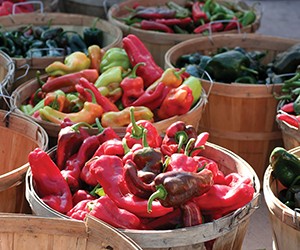While their geographical settings are classified as desert, Arizona and New Mexico are anything but food deserts. These Southwestern states produce bumper crops of agricultural products that encompass pecans, citrus fruits, chile peppers, wine grapes, olive oil and much more. They are also known for distinctive cuisine, drawing on multicultural influences that reflect Native American and Hispanic heritage as well as the latest food trends. Fortunately for groups, there is no end to the venues and activities that showcase the region’s cornucopia of flavors, agriculture and culinary traditions.
Arizona
When anyone asks what can possibly grow in the Arizona desert, the likely answer is just about everything. For many out-of-town visitors, the scope of what the state produces is often a huge surprise.
“People don’t realize how many farms there are in Arizona, even right in the Greater Phoenix area,” said Lori James, president and owner of AZA Events, a destination management company serving all of Arizona. “For instance, we’re one of the world’s largest producers of lettuce and honey—things people would never imagine.”
For meeting groups, there is no shortage of farms that offer event space, tours and other opportunities to enjoy what they produce. Among the most popular is Queen Creek Olive Mill, where Perry and Brenda Rea produce extra virgin olive oil at their 100-acre spread planted with over 7,000 olive trees. Located about 40 miles south of Phoenix and 94 miles north of Tucson, Queen Creek welcomes groups with a variety of events and activities that include tours, olive oil tastings and pizza-making classes.
“Once you see how olive oil is processed, you come away with a new appreciation for the differences in quality,” James said. “This is a really great place for events.”
Queen Creek offers several indoor and outdoor event venues, including the chance to enjoy a catered lunch or dinner in the olive groves or in the mill room where the olives are pressed into oil and bottled.
Another of James’s favorite venues is the Farm at South Mountain, which welcomes groups of up to 3,000 to its 10-acre expanse of pecan groves, vegetable gardens and parklands. The options range from casual picnics to elegant cocktail parties with food stations. Groups can hold outdoor events in areas such as Stone Grove, which includes a wood-burning oven amid handcrafted stone walls. The property also hosts private dinners at its fine-dining restaurant, Quiessence, where dishes are created from produce grown on the property or from nearby farms.
In October Tucson became the first American city to become part of the UNESCO Creative Cities Network and the only one to be selected because of culinary innovation and commitment to preserving the gastronomical heritage of Southern Arizona.
“Our agricultural heritage extends back over 4,000 years as the longest known continuously cultivated area in North America,” said Dan Gibson, spokesman for Visit Tucson. “We also have an incredibly unique mix of cultural influences reflected in our food.”
According to Gibson, UNESCO took note of the research on sustainable growing practices conducted by the University of Arizona and the work done on preserving historic crops by Native Seeds, a local organization.
Among places in Tucson where visitors can see this preservation in action is Mission Garden, a living agricultural museum where the grounds are planted with heirloom orchards and vegetable gardens. Interpretive tours of Mission Garden, which is planted in the style of a Spanish walled colonial garden on a site once farmed by the ancient Hohokam and Tohono O’odham tribes, can be arranged for groups.
PageBreak
Located in Scottsdale, The Simple Farm produces caramel candies from its herd of Nubian dairy goats on the property. Groups can try bottle-feeding baby goats and hold catered events in such spaces as The Orchard, Teepee Garden and the Farmhouse Garden. The farm has recently teamed up with The Scottsdale Resort to hold Suppers at the Farm in one of its garden areas.
In Sedona, where the surrounding Verde Valley is Arizona’s most celebrated wine region, Alcantara Vineyards is a standout venue for wine tasting, tours and group events, according to James. Set along the Verde River where bald eagles can be spotted flying overhead, Alcantara is planted with over 13,000 vines and produces 12 varietals.
“The owner, Barbara Predmore, one of the early leaders of Arizona’s farm-to-table movement, created this beautiful winery out of a place that was just rocks,” James said. “We have used Alcantara for a day trip or for many lunches and wine-pairing dinners where you can bring in Native American hoop dancers.”
New Mexico
New Mexico is a place to savor distinctive cuisine that owes its origins to a flavorful hybrid of Native America, Hispanic and Anglo pioneer influences. Its chief component is the chile pepper, the state fruit, which is grown in southern New Mexico’s Hatch Valley and harvested during the late summer. Some chile peppers are picked while still green and then roasted, while others are left to turn red on the vine and then frequently dried for use in sauces and stews.
Opportunities for groups to not only sample New Mexican cuisine but to learn about its nuances and heritage abound, according to Lydia Griego-Hansen, co-owner of Destination Southwest, an Albuquerque-based DMC.
“One of the biggest things we do for incentive groups is to talk about our chile peppers and Native American traditions and why they make our cuisine different from even that of Texas or Arizona,” she said. “We’ll have them meet with a local chef who makes jams, jellies, teas and other products from our indigenous plants. If a group is meeting in Las Cruces, we can take them to the Chile Pepper Institute at New Mexico State University to learn about the different pepper varieties and their degrees of heat.”
Among Griego-Hansen’s’ favorite venues for introducing groups to Native American culinary influences is Albuquerque’s Indian Pueblo Cultural Center. Here groups can enjoy events catered by the on-site Pueblo Harvest Cafe, where chef Michael Giese has been named Chef of the Year by the New Mexico Restaurant Association. Among the specialties are Indian fry-bread tacos heaped with picante sauce and locally grown pinto beans.
Another Albuquerque venue emphasizing local food products is the group-friendly El Pinto Restaurant and Salsa Company, which makes and sells a wide variety of red and green chile salsa and serves dishes based on recipes from the owner’s grandmother Josephina Chavez-Griggs.
“It’s in an old hacienda that serves very authentic New Mexico food—they really work well with corporate groups,” Griego-Hansen said.
For a bucolic experience just outside of Albuquerque, a top choice is Los Poblanos Historic Inn & Organic Farm, which grows lavender as well as Chimayo chiles, rare varieties of squash, beans and other varieties of heirloom produce on its 25-acre grounds. The 20-room inn, which is available for meetings and corporate retreats, is a popular event venue that offers cooking classes as well as a series of four-course Long Table dinners served for up to 60 guests.
Just how varied and complex New Mexican cuisine can be is the focus of the Santa Fe School of Cooking, where the myriad offerings for groups include workshops on cooking with green or red chiles, restaurant walking tours of downtown Santa Fe, culinary teambuilding and more.
“We’ve been able to do some amazing things with the Santa Fe School of Cooking, including cooking classes held out in the vineyards,” said Arlene Schiffer, president of Santa Fe-based Passport DMC. “You can also arrange to bring the group to a lovely private home where you cook in the kitchen and then sit down and have the meal.”







